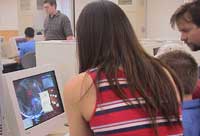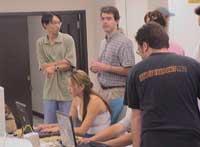UCI's Computer Game Development Course Hosts Open House
 Calit² has been fostering an emerging "gaming consortium," which abides by the principle that the technology that drives the younger generation will come to define that generation in everything it does as it gets older, much as radio and TV came to define previous generations. This group seeks to turn the study of computer game theory, practice, and culture into an academically accepted research discipline.
Calit² has been fostering an emerging "gaming consortium," which abides by the principle that the technology that drives the younger generation will come to define that generation in everything it does as it gets older, much as radio and TV came to define previous generations. This group seeks to turn the study of computer game theory, practice, and culture into an academically accepted research discipline.
In this context, teams of students in Information and Computer Science 187 at UCI, a course taught by Lecturer Dan Frost, recently demonstrated computer game projects, which had been developed over the course of the 10-week spring quarter. Some 100 people, including professors, parents, siblings, and people representing the game industry, came to experience the results produced by most of the course's 15 teams at an open house held June 14.
The charge of the course for each team was to design a game, develop user documentation, and demonstrate the game's "playability" by quarter's end. Explained Frost, "By the fifth week of the quarter, each team was asked to produce a design document that provided the background story, technical details of how the game would work and be played, and sketches of artwork. The students then had the remaining five weeks to turn their visions into a playable reality."
Most were single-workstation (PC-based) games but a full half-dozen were networked gaming environments. One game, Perihelion, ran on a peer-to-peer network of Linux, Windows, and Macintosh machines.
Student Aaron Brunstetter was a member of the team that developed Death and Destruction, a multi-player first person shooter in a large outdoors environment. "The exciting part for me," said Brunstetter, "was that the work was based on imagination. We imagined how we wanted the game to be, then we had to figure out how to create that environment. This kind of challenge was new and very exciting." It turns out that many students took advantage of the many resources specific to gaming available on the Web: tutorials, open source libraries, code snippets, etc. But the teams also relied on fellow teams for advice.
Said Ryan Karg, also on the Death and Destruction team, "We built many things from scratch, other stuff we acquired, but the real challenge was to figure out how to integrate the various parts together."
Hung Le, a member of the team that created a game called Orbit, agreed: "Our biggest problem was revision control as we shared various programming modules with each
other -- often on a daily basis. We realized we needed a team leader to oversee management of this aspect."
Cleverness also seemed to be a requirement for success. "Our game," said Brunstetter, "included a large terrain, and to map that some two million triangles had to be drawn and re-drawn. That was obviously too compute-intensive to be done in real time on a single PC platform, so we needed to figure out some programming tricks to create the same effect."
 This sentiment was echoed by many students. Said Michael Beeson, one of the team members that produced the game Defiance, "This course represented an aspect of computing we typically don't get into. While our curriculum mostly focuses on Java, for example, here we were challenged to apply mathematical concepts and some of the more hard-core programming languages like C and C++. We had to find information and
This sentiment was echoed by many students. Said Michael Beeson, one of the team members that produced the game Defiance, "This course represented an aspect of computing we typically don't get into. While our curriculum mostly focuses on Java, for example, here we were challenged to apply mathematical concepts and some of the more hard-core programming languages like C and C++. We had to find information and
learn how to do things on our own."
Another theme among the students was the importance of teamwork for project success. Said Karg, "We learned to work as a group toward the same goal. This is the most demanding project I've ever done."
Senior management from Electronic Arts, the largest game publisher in the country, came from the local office ("EA Pacific") to judge the games and award prizes in engineering, art, and game design. Their presence also caused the students to think about how to articulate the nature of their games, the technical challenges they encountered and overcame, and salesmanship aspects of promoting their games to first-time players.
ICS 187 is one of several "project" courses the Information and Computer Science department offers. The course offers students interested in the technical and programming side of computer game development an opportunity to apply learning from earlier courses in software engineering, artificial intelligence, networking, computer graphics, and user-interface design. Students, including non-ICS majors, are put on teams to take advantage of similar goals and complementary skills.
One of Frost's goals is to have the course cross-listed in Studio Art to invite more art majors to participate. Even so, the class proved extremely successful in attracting a multidisciplinary group of students: most teams featured a diverse collection of expertise spanning programming, art, animation, music/sound effects, physics, networking, etc.
And how will grades be assigned? Frost, trained in folklore and mythology at
Harvard as an undergraduate, and a specialist in computer graphics and artificial intelligence, said, "It depends on the merits of the game: Some have great graphics, music, or a wonderful storyline but not necessarily all together. The most important factor is game play. I ask: Is this a fun game to play?"
Student demand for the course has been very high. As a result, Frost hopes to team teach it next year with adjunct instructor Celia Pearce. "Students are fascinated by computer games," said Frost, "but to many people a 'computer game' equates to 'mindless pastime' or worse. I see computer games as complex pieces of both software and art, that students are extremely motivated to create their own games, and, not incidentally, that Irvine is one of the world centers of the computer game industry. It would be a shame not to take advantage of these factors at our university."
Related Links
Meta-Game Group
ICS, UCI
Claire Trevor School of the Arts, UCI
CRCA, UCSD
